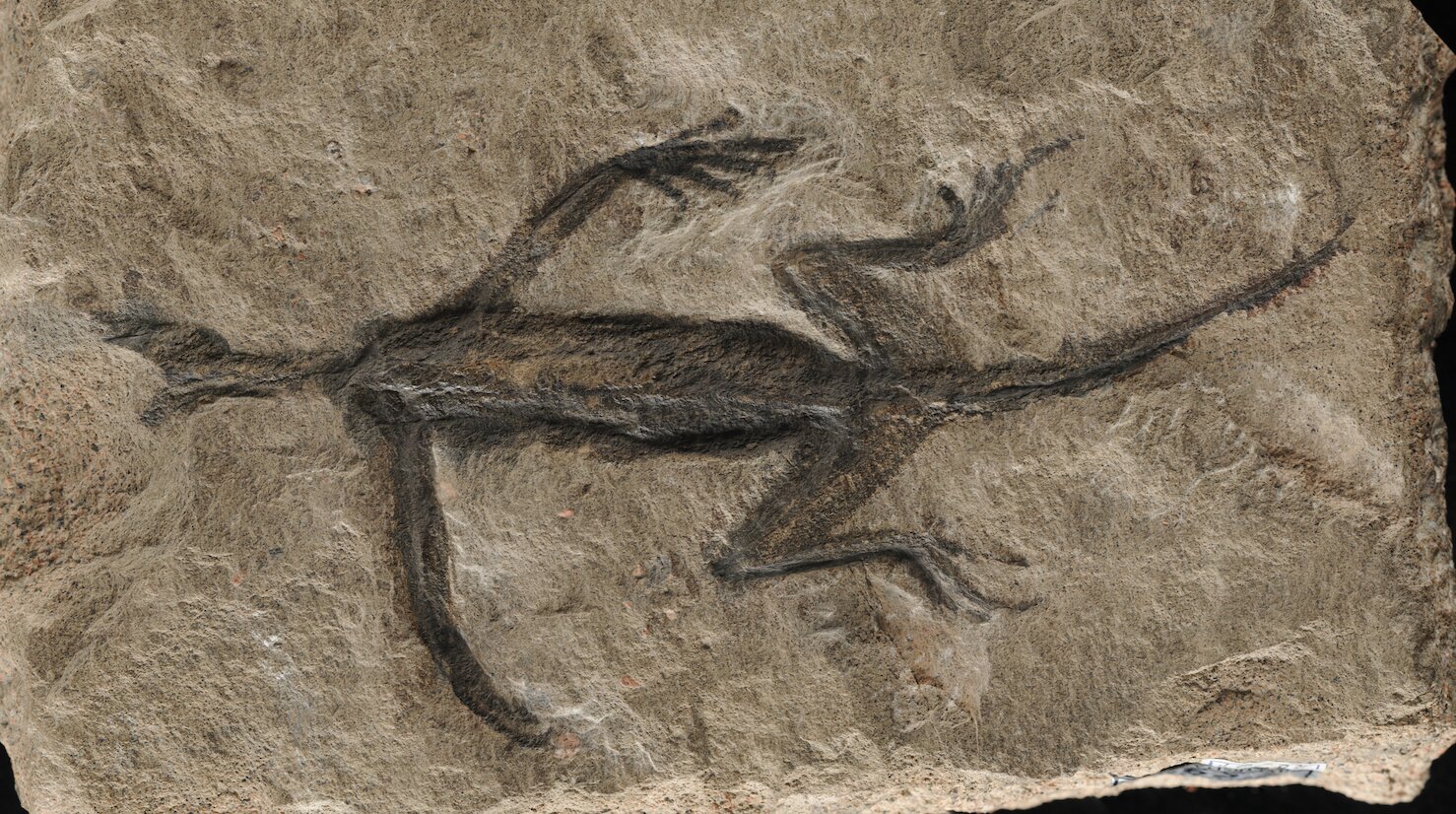Tridentinosaurus antiquus was discovered in the Italian Alps in 1931 and was thought to be an important specimen for understanding early reptile evolution – but has now been shown to be partly a fake. Its body outline, which appears dark against the surrounding rocks, was initially interpreted as preserved soft tissue but is now known to be painted. Credit: Dr. Valentina Rossi
× Close
Tridentinosaurus antiquus was discovered in the Italian Alps in 1931 and was thought to be an important specimen for understanding early reptile evolution – but has now been shown to be partly a fake. Its body outline, which appears dark against the surrounding rocks, was initially interpreted as preserved soft tissue but is now known to be painted. Credit: Dr. Valentina Rossi
A 280-million-year-old fossil that has baffled researchers for decades has been shown to be partly a fake, after a new examination of the remains.
The discovery has led the team, led by Dr. Valentina Rossi from University College Cork, Ireland (UCC), to urge caution about how the fossil is used in future research.
Tridentinosaurus antiquus was discovered in the Italian Alps in 1931 and was thought to be an important specimen for understanding early reptile evolution. Its body outline, which appears dark against the surrounding rocks, was initially interpreted as preserved soft tissue. This led to its classification as a member of the reptile group Protorosauria.
However, this new research, published in the journal PaleontologyHe reveals that the famously well-preserved fossil is mostly just black paint on a rock surface carved into the shape of a lizard.
The alleged fossilized skin has been celebrated in articles and books but has never been studied in detail. The fossil's somewhat bizarre preservation has left many experts unsure about which reptile group this strange lizard-like animal belongs to, and more generally its geological history.
Dr. Valentina Rossi with a photo of Tridentinosaurus antiquus. The fossil, which was discovered in the Italian Alps in 1931, was thought to be an important specimen for understanding early reptile evolution, but has now been shown to be partly a fake. Its body outline, which appears dark against the surrounding rocks, was initially interpreted as preserved soft tissue but is now recognized as paint. Credit: Zixiao Yang
× Close
Dr. Valentina Rossi with a photo of Tridentinosaurus antiquus. The fossil, which was discovered in the Italian Alps in 1931, was thought to be an important specimen for understanding early reptile evolution, but has now been shown to be partly a fake. Its body outline, which appears dark against the surrounding rocks, was initially interpreted as preserved soft tissue but is now recognized as paint. Credit: Zixiao Yang
Dr Rossi, from the School of Biological, Earth and Environmental Sciences at University College Cork, said: “Fossil soft tissues are rare, but when they are found in a fossil they can reveal important biological information, for example, external colour, internal anatomy and physiology. The answer to all our questions was right before our eyes, and we had to study this fossil specimen in detail to uncover its secrets, even those that we might not have wanted to know.
Microscopic analysis showed that the texture and composition of the material did not match real fossilized soft tissue.
Initial investigation using UV imaging revealed that the entire sample had been treated with some type of coating material. Coating fossils with varnish and/or paint was the norm in the past, and is sometimes still necessary to preserve a fossil specimen in museum cabinets and exhibitions. The team hoped that, beneath the layer of paint, the original soft tissue would still be in good condition to extract meaningful ancient biological information.
The results suggest that the body outlines of Tridentinosaurus antiquus were created artificially, likely enhancing the fossil's appearance. This deception has misled previous researchers, and caution is now urged when using this sample in future studies.
The team behind this research includes contributors from Italy at the University of Padua, the Nature Museum of South Tyrol, and the Science Museum of Trento.
“The strange preservation of Tridentinosaurus has puzzled experts for decades. Now, it all makes sense. What was described as charred skin is just paint,” said co-author Professor Evelyn Kostacher, coordinator of the Living with a Supervolcano project. “
However, all is not lost, and the fossil is not a complete fake. The bones of the hind limbs, in particular the femur, appear authentic, although poorly preserved. Furthermore, new analyzes have shown the presence of small bony scales called osteoderms – like those of a crocodile – on what may have been the back of the animal.
This study is an example of how modern analytical paleontology and rigorous scientific methods can solve a nearly century-old fossil mystery.
more information:
Forged soft tissues have been uncovered in the oldest fossil reptiles from the Early Permian of the Alps. Paleontology (2024). doi: 10.1111/bala.12690

“Explorer. Unapologetic entrepreneur. Alcohol fanatic. Certified writer. Wannabe tv evangelist. Twitter fanatic. Student. Web scholar. Travel buff.”



